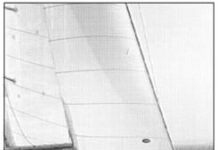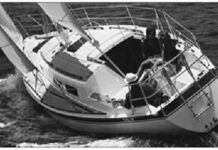Stiletto
It's hard to mistake the Stiletto's appearance, with blazing topside graphics and aircraft-style, pop-top companionway hatches. It's also hard for the average sailor to appreciate the sophistication of the Stiletto's construction--epoxy-saturated fiberglass over a Nomex honeycomb core.
UWB 333
The arithmetic of weights and displacements prevents us from ever realizing a trailerable boat that will sail at the preferred half-submerged condition of our hypothetical craft. But you can get a trailerable hull by this scheme that will sail about one-third submerged, which probably is close enough, and that boat will have more than enough righting moment for reasonable sail-carrying. You also can get a boat that weighs relatively little out of the water compared to its displacement in the water--exactly the characteristic you want in a blue-water trailer sailer. I describe this design as "Ultra Water Ballasted."
Block Island 40
In its heyday, the Block Island 40 had a good racing record. In the 1960 Bermuda Race six of the first 11 places were won by BI 40s, and in 1978, the BI 40 Alaris won her class. Its PHRF rating varies between rig (sloop or yawl) and fleet from a low of 156 to a high of 186. The average seems to be 165. It's difficult to make comparisons, but more contemporary boats with similar ratings include the Hunter 33, Irwin 34 Citation and Island Packet 38. But what's the point? The BI 40 is not a round-the-buoys racer. She's a cruising boat displacing 20,000 pounds.
Brewer 12.8/44
The Brewer 12.8 and the Brewer 44 are developments of the Whitby 42, a cruising boat from the board of Ted Brewer. Brewer is one of the great modern cruising boat designers. His boats are well-mannered, attractive and practical. To improve windward performance, a high aspect ratio centerboard extends through the bottom of the 12.8's shallow keel. Since the board is not ballasted, it does not affect stability, but can be used when reaching to shift the center of lateral resistance.
Bristol 35.5C
The Bristol 35.5C, which also came in a full-keel version (without the "C"), is an extraordinarily orthodox boat. There simply are no extremes in design, construction or performance, unless it is in her ability to flaunt her stern downwind and burn a lot of boats when beating in light to moderate air.
Cal 31
The Cal 31 is the thirteenth Bill Lapworth-designed Cal boat between 27' and 34' built by the Costa Mesa, California firm. Cal, a pioneer in fiberglass sailboat construction, later became a division of Bangor Punta Marine, whose boatbuilding group also included O'Day and Ranger. Cal boats went out of production in 1989. Cal and Bill Lapworth are best known for the breakthrough Cal 40, which many years ago began the trend toward moderately light displacement, fin-keel spade-rudder ocean racers.
Cal 34
Bill Lapworth didn't invent light-displacement cruiser-racers, but his name is indelibly linked with the type. At 15,000 pounds of displacement on a 30' waterline, the Cal 40 is still a fairly light boat, especially considering the low-tech materials and techniques available when she was introduced. Lapworth designed a number of smaller sisters to the Cal 40 in the late 1960's, all looking as alike as peas in a pod.
Cal 40
Three decades have passed since Lapworth drew the Cal 40. Today the Cal 40 is a dated design, having been surpassed in her revolutionary features by her descendents. She remains among the esteemed elite of racing yachts, but she is not especially light, long on the waterline, or fast compared to current designs.
Cal 46
The Cal 46 was introduced in 1967. One reader said he thinks about 10 were built. For several years it was called the Cal Cruising 46. The Cal 2-46, with a redesigned deck, cockpit and interior layout, succeeded it from 1973 until 1976. The Cal 3-46, virtually the same as the 2-46 except for some minor interior changes, was built in 1977 and 1978.
Cheoy Lee Clipper 36/42
Cheoy Lee Shipyards of Hong Kong is one of the first molders of fiberglass boats in Asia. The Cheoy Lee Clipper 36 was built from 1969 to about 1988, if the BUC Research Used Boat Price Guide is to be believed. The Clipper 42 was introduced a year later, in 1970. Eventually both were replaced by the more contemporary designs of David Pedrick. We doubt that very many Clipper series boats were brought into the U.S. during the mid or later 1980s.












































